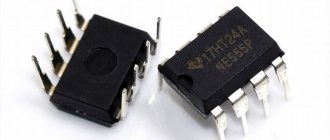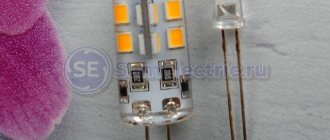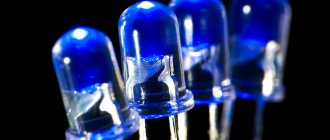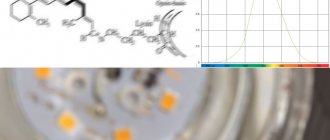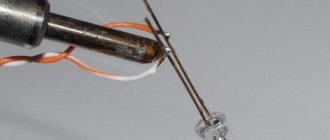What is LED and what is it eaten with?
In everyday life, we very often come across the abbreviation LED, for example, when talking about displays. What is it? So, from English LED stands for Light Emitting Diode, which can be literally translated as “diode emitting light.” Now everything becomes much clearer. This means that this is still one of the types of diode, or rather even its special type. Let's try to figure out where in everyday life we encounter such diodes and how they work in general.
Most often you can see these 3 letters when viewing the characteristics of equipment that has displays. For example, matrices on TVs, phones and monitors are often equipped with LED backlighting. To put it simply, LED is a light diode, or light-emitting diode. It's easier, right? So how does it work?
Types and main parameters of LEDs
In the diagram, the LED is indicated as a regular diode with two parallel arrows pointing outward, indicating its emitting nature. There are a large number of types of LEDs on sale, which differ in functionality, design, power, glow color and other properties.
Based on their purpose, LEDs are divided into two types - indicator and lighting.
Indicative:
- SMD LEDs;
- super bright Super Flux “Piranha”;
- DIP LEDs (Direct In-line Package);
- Straw Hat (“straw hat”).
Lighting:
- COB (Chip On Board) LEDs;
- SMD LED;
- filament (Filament LED).
Indicative
Indicator LEDs are characterized by low power and moderate brightness. They are used for color indication of operating modes of various devices and equipment, as well as for illumination of displays and instrument panels. Types of indicator LEDs:
- DIP LEDs. The emitter crystal is located in an output housing, which most often is a convex lens. The downside is the small radiation scattering angle.
- “Piranha” is an ultra-high brightness emitter with four pins, ensuring its convenient mounting on the board. Demanded for illuminating devices in cars and advertising signs.
- "Straw Hat" A cylindrical two-terminal device with a significant radiation scattering angle and an increased lens diameter. Used in decorative structures and alarm lights.
- SMD LEDs. Ultra-high brightness devices are housed in housings designed for SMT mounting. Their markings indicate dimensions in inches (hundredths thereof) or in mm. LED strips are manufactured based on SMD LEDs.
Lighting
Lighting LEDs are found in the design of lanterns, headlights, and strips. They differ in the power and brightness of the glow. Most lighting fixtures are housed in SMT mounting housings. Available in two varieties of white:
- cool white – cold;
- warm white – warm.
An SMD lighting LED is a heat-sinking substrate on which a emitting crystal treated with a phosphor composition is mounted.
What is the difference from a regular diode?
It turns out that a light diode is still different from a conventional (signal) diode. The main difference, of course, lies in the design. Thus, the LED has a special hemispherical protection that protects it from shocks and other mechanical influences from the outside. Also very interesting is the fact that the LED junction itself emits quite a few photons. It is for this reason that the LED housing is specially made of epoxy resin, which allows photons going in other directions to be directed straight up.
Sometimes there are very unusual forms of LEDs. Among them are rectangular, cylindrical and even arrow-shaped. It all depends on where the light needs to be concentrated, and this depends on the purpose for which this LED is created.
Applications of LEDs
Such products are actively used in various fields: illuminated advertising, home and industrial lighting, automotive lighting, traffic lights and road signs, interior design, landscape and architectural lighting, and much more.
Advantages of LEDs:
- significant duration of operation;
- environmental Safety;
- high reliability and reliability;
- energy saving;
- high quality lighting;
- low operating costs.
Mixing colors
Modern diode strips can produce different shades of luminous flux. One device can produce a monotonous color. When creating a multi-chip device, it is possible to obtain a huge number of different shades. Like a TV or computer monitor, a diode can create any color using the RGB model (which stands for red, green, blue).
This is a simple principle to understand how RGB LEDs work. Using this technology, you can create white lighting. To do this, all three colors are mixed in equal proportions.
However, in addition to the presented technology, it is possible to obtain a white glow by connecting a short-wave radiation diode (ultraviolet, blue) together with a yellow phosphor-type coating. When yellow and blue photons are combined, the result is white light.
Basic rules for connecting LEDs
The LEDs are designed to be connected only to direct current sources, maintaining polarity. There are three options for determining polarity:
- According to the length of the leg (except SMD). The longer leg is the cathode, and the shorter leg is the anode. SMD LEDs have a cut (key), which is always located closer to the cathode.
- Using a multimeter. The device is set to the “Dialing” mode. Red and black probes are installed on the terminals. If the device lights up, it means that the red probe was connected to the anode, and the black probe to the cathode. If the glow does not appear, then you need to change the position of the probes. If the result has not changed (there is no light), then the device has failed.
Why warm light?
Why are warm lamps better? There is this graph of lighting “comfort” depending on the CG floating around on the Internet - the Kruithof curve
Kruithof curve
The Kruithof curve does not contain the actual data that became the basis for its construction, but only indicates the approximate ratio of illumination and color temperature for comfortable artificial lighting. In this regard, the scientific value of the curve is ambiguous.
It clearly shows that if we want “comfortable” cold light, then the illumination should be > 1000 lux in the room , and this is already expensive. Believing this or not is a matter of purely personal opinion - for example, I agree with her, with only one condition - this graph is completely unsuitable for LED lighting.
Connection methods
The simplest option is to connect to a low-voltage DC source.
The most convenient and safest option is to connect the LED to a battery or accumulator by including a low-power resistor in the circuit. Its function is to limit the current flowing through the pn junction to a certain value. Without this element, the LED will quickly lose its working properties.
The resistor is selected based on resistance and power. Calculation of resistance using the formula:
R = (Usupply – Upassport.)/Inom., Ohm, in which:
- Usupply – power supply voltage, V;
- Upassport. – voltage drop, rated value, V;
- Inom. - rated current.
The resulting value is rounded up to the nearest nominal value from the E24 series. After this, the power that the resistor must dissipate is calculated.
P = Inom.2 x R, where R is the resistance value selected from the table.
You can carry out all these steps quickly and easily using an online calculator.
Further development of LED technology
The first ultra-bright blue LEDs based on InGaN were demonstrated by Sh. Nakamura from the Japanese company Nichia.
This marked the beginning of a new era in the use of LEDs - use as a light source for lighting. The combination of blue light and yellow phosphorus produced white light. Thanks to this discovery, LED technology began to develop rapidly. In February 2008, employees of Bilkent University in Turkey reported receiving 300 lumens of visible light per watt of light power. It was a warm white color produced using nanocrystals.
In January 2009, researchers from Cambridge, led by S. Humphrey, reported the growth of gallium nitride on a silicon substrate. This method can reduce production costs for the production of ultra-bright LEDs by 90% compared to growing structures on a sapphire substrate.
How to connect LEDs to a 220 V AC network via a power supply
There are several types of power supplies:
- Stabilized constant voltage sources for 5 Volt and 12 Volt LEDs. When network parameters fluctuate, the voltage at the output of such a power source remains constant and equal to the value stated in the passport. LED lamps are connected through resistors.
- Driver – switching power supply with stabilized current. Characteristics that are taken into account when choosing it: maximum and minimum output voltage, output (operating) current. The driver contains a circuit that stabilizes the current during surges in the 220 V input voltage. When connecting an LED emitter to the driver, a resistor is not required.
Principle of operation
When considering how an LED works, it is necessary to understand the basic principle of operation of such devices. The device of the presented type has one electron-hole junction. This is due to the different principles of conductivity of the illuminator components. One semiconductor has an excess of electrons, and the other has an excess of holes.
Through the doping process, the holey material is enriched with negative charge carriers. If a current is applied where the semiconductors are enriched with opposite charges, a forward bias will result. Electricity will flow through the junction of these two materials.
In this case, charge carriers with different electrical status fuse in the diode body. When holes and electrons collide, a certain amount of energy is released. This is a quantum of light flux. It is called a photon.
Methods for creating circuits from several LEDs - serial and parallel connection
When connecting several light-emitting devices to a power source, two connection options can be used - serial and parallel.
Sequential
A series connection represents a circuit of semiconductor devices in which the cathode of the first emitter is soldered to the anode of the next one - and so on. A current of the same value flows through all elements of a series circuit, and the voltage drop is summed up. The power of the power supply is selected equal to or greater than the sum of the powers of each element.
Cons of serial connection:
- If there are a significant number of circuit elements, it is necessary to choose a high-voltage power supply.
- If one LED diode fails, the entire circuit stops working.
In long strips with 60-70 diodes on each element there is a voltage drop of approximately 3 V, that is, such strips can be connected to a 220 V network through a rectifier.
Parallel
When connected in parallel, the voltage on all elements of the circuit will be equal, and the currents of each LED will be summed up. The main problem in this case is that LED lamps, even from the same batch, often have different characteristics. Therefore, if you put one common resistor, different current values can be supplied to the light bulbs, as a result of which some elements will shine too brightly, while others will shine dimly. The solution to the problem is to install separate resistors for each diode.
Disadvantages of parallel connection:
- a large number of circuit elements due to the need to use individual resistors for each diode;
- a significant increase in load when one LED diode burns out (if one powerful resistor is used for the entire circuit).
Mixed
This is the most suitable option for connecting LEDs, since it allows you to at least partially compensate for the disadvantages of serial and parallel connections. In this case, chains of sequential elements are connected in parallel. This method is used in modern Christmas tree garlands or ribbons. The advantage of this solution: even if one or more parallel chains fail, the rest will continue to light properly.
Materials
The following table shows the dependence of the LED glow color on the semiconductor material
| Infrared | λ > 760 | ΔV < 1.9 | Gallium arsenide (GaAs) Aluminum gallium arsenide (AlGaAs) |
| Red | 610 < λ < 760 | 1.63 < ΔV < 2.03 | Aluminum gallium arsenide (AlGaAs) Gallium arsenide phosphide (GaAsP) Aluminum gallium indium phosphide (AlGaInP) Gallium(III) phosphide (GaP) |
| Orange | 590 < λ < 610 | 2.03 < ΔV < 2.10 | Gallium arsenide phosphide (GaAsP) Aluminum gallium indium phosphide (AlGaInP) Gallium(III) phosphide (GaP) |
| Yellow | 570 < λ < 590 | 2.10 < ΔV < 2.18 | Gallium arsenide phosphide (GaAsP) Aluminum gallium indium phosphide (AlGaInP) Gallium(III) phosphide (GaP) |
| Green | 500 < λ < 570 | 1.9[32] < ΔV < 4.0 | Indium gallium nitride (InGaN) / Gallium(III) nitride (GaN) Gallium(III) phosphide (GaP) Aluminum gallium indium phosphide (AlGaInP) Aluminum gallium phosphide (AlGaP) |
| Blue | 450 < λ < 500 | 2.48 < ΔV < 3.7 | Zinc selenide (ZnSe) Indium gallium nitride (InGaN) Silicon carbide (SiC) as substrate Silicon (Si) as substrate — (in development) |
| Violet | 400 < λ < 450 | 2.76 < ΔV < 4.0 | Indium gallium nitride (InGaN) |
| Purple | different types | 2.48 < ΔV < 3.7 | Dual blue/red LEDs, blue with red phosphor, white with magenta filter |
| UV | λ < 400 | 3.1 < ΔV < 4.4 | diamond (235 nm)[33] Boron nitride (215 nm)[34][35] Aluminum nitride (AlN) (210 nm)[36] Aluminum gallium nitride (AlGaN) Aluminum gallium indium nitride (AlGaInN) — (down to 210 nm)[37] |
| White | Wide range | ΔV = 3.5 | Blue/UV diode and yellow phosphor |
Durability
Diodes are considered long-lasting devices. This is due to their design. However, if the LEDs on the lamp do not work, their service life may have expired. This can be determined by the intensity of the glow and color change.
Experts also note that the service life of low-power devices is much longer. But even in the brightest strips or lamps, diodes are guaranteed to operate for 20-50 thousand hours. Since they do not have fragile structural elements, mechanical impacts are more likely not to harm such illuminators.
By studying how an LED works, you can understand the design principle of this device, as well as its operational characteristics. This equipment is considered to be the illuminators of the future generation.
Crystal sizes
80 Watt LED Matrix
The ultra-bright element is built on crystals whose dimensions are indicated as mil - a thousandth of an inch. If you convert the value into millimeters, you get 0.0254 mm. Standard crystal sizes are 30x30 and 45x45 mil.
Experts use digital calipers with sharp ends to determine the size of the crystal. The tool allows you to identify the value with an accuracy of 0.01 mm. It is enough for the average person to know that size correlates with power:
- 1 W – 45x45 mil or 30x30 mil;
- 0.75 W – 24x40 mil;
- 0.5 W – 24x24 mil.
Manufacturers recess the LED crystal into the housing, so a micrometer is not used for measurement.




